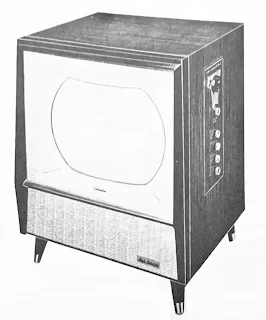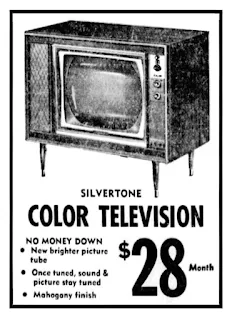Meanwhile, Sears had introduced the first Kenmore-brand automatic washer in July 1947. According to the advert, this modern marvel "does your washing automatically while you go shopping." Kenmore laundry equipment was manufactured by the Nineteen Hundred (later Whirlpool) Corporation.
The first Kenmore-brand clothes dryer was introduced in July 1949. The unit was "created to fit the pattern of modern living," or so said the ad copy. This concept fits in with the mid-century mindset, whereby Americans were fascinated by all that was modern, convenient and time-saving.
Sears' first televisions appeared in stores in December 1948. This black & white Silvertone set featured a mahogany veneer cabinet, AM radio receiver and "BIG 10-inch picture tube."
In June 1954, Sears stores started displaying a prototype color television. These were for display purposes only and not for sale. The first color sets were sold in the spring of 1957. One might expect that such a momentous endeavor would have been promoted with a great deal of hoopla. Not so. Apparently, contemporary newspaper ads did not even include a photo or drawing of any Sears color set or sets. There was only this modest "come in and see" text block.
We're including a photo of the first color set sold by Sears. The Silvertone
7140 model was manufactured by the Radio & Television Corporation of Chicago.
It took till 1961 to actually show a color television in a Sears newspaper advertisement. Even then, the actual cost of the Silvertone set was not mentioned. There was only a vague reference to "$28 (per) month." The $440 price tag of a color television in 1957 translates -in today's buying power- to around $4,800. Is it any wonder that Sears balked at the heavy promotion of such an expensive item?
The first Montgomery Ward color sets debuted in October 1964. The Airline model depicted here was also an "all-channel" set. Like the previous Penncrest model, it came with a paltry 90-day manufacturer's warranty (today's sets are usually warrantied for one year). Early color sets were problem-prone. A popular urban legend of the day said that owners of a color set needed to maintain a bedroom for the TV repairman, lol.
J.C. Penney's first color sets were in stores by December 1963. The Penncrest Color Consolette, seen above, was being sold in late 1964. This was a so-called "all-channel" television, which received both VHF (very high frequency) and UHF (ultra high frequency) channels. Note: VHF channels ranged from 2 to 13 with those of the UHF band running from 14 to 83. BTW, there was no "channel 1."
The first Montgomery Ward color sets debuted in October 1964. The Airline model depicted here was also an "all-channel" set. Like the previous Penncrest model, it came with a paltry 90-day manufacturer's warranty (today's sets are usually warrantied for one year). Early color sets were problem-prone. A popular urban legend of the day said that owners of a color set needed to maintain a bedroom for the TV repairman, lol.













